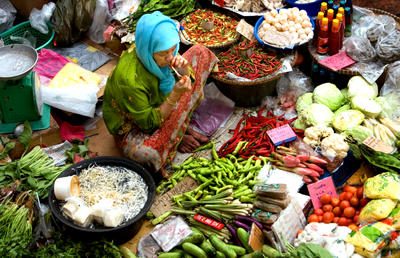But it has failed to address arguably the single most important obstacle to economic rejuvenation in Malaysia.
The government’s current efforts are aimed at tackling some of Malaysia’s deepest structural problems so the country can finally join the select handful of countries that have successfully made the leap to high-income status since the 1950s. Wages in Malaysia have climbed to the point where the country can no longer compete internationally in labour-intensive manufacturing. But skills and systems haven’t improved to a level that allows Malaysia to compete effectively in the same product space as advanced countries. Without further reforms, it is difficult to see how Malaysia can escape from this middle-income trap.
Malaysia’s New Economic Model, designed to more than double the country’s per capita income by 2020, is driving the effort. Its central pillar — the Economic Transformation Programme — focuses government and private sector attention on 12 key economic areas (ranging from agriculture to tourism) and six cross-cutting reforms (ranging from human capital development to inequality reduction). Its second pillar, the Government Transformation Programme, is designed to improve service standards in key government programs.
But more important than the content of the programs is the systematic and business-like way that the Najib administration has gone about implementing them. Each program has actionable and measurable milestones, with an annual scorecard that is available on the web and open to public scrutiny. To underline the credibility of the effort, the government has hired an international auditing firm (PricewaterhouseCoopers in 2012) to validate the data underpinning the targets and invited a panel of renowned economists from around the world to review and critique the program and its results. The message is clear — program execution is paramount.
With such transparent and direct accountability, it should come as no surprise that virtually all targets in the Economic Transformation and Government Transformation Programmes have been met or exceeded. Private investment has increased, enabling Malaysia’s robust macroeconomic performance despite a tepid global economy. The World Economic Forum now ranks Malaysia 21st out of 142 economies in its world competitiveness rankings — up from 26th in 2010.
All of this would be cause to celebrate, but for one important caveat. The programs do nothing to address a long-standing affirmative action program called the Bumiputera — or sons of the soil — policy. Under this policy, Bumis (ethnic Malays and indigenous groups) get preferential access to a range of economic opportunities, including jobs, education, business ownership, real estate, procurement contracts and finance. The Bumiputera policy was introduced after race riots in 1969. It made manifest sense at the time and helped reduce inequality in the country. But the policy is an anachronism today. Not only does it undermine Prime Minister Najib’s ‘1Malaysia’ policy — which emphasises national unity and ethnic harmony — it also contributes to increased inequality in Malaysia, which is now more severe within ethnic groups (including among Bumis) than between them.
Prime Minister Najib has tried hard to reform the Bumiputera policy, but he has had to compromise in the face of intense pressure from within his own party, as well as from powerful ethnic Malay interest groups. The Malay elite have reaped enormous benefits thanks to the policy, and they are unlikely to relinquish their privileges easily.
What’s more, their support partly explains why Najib enjoys a high standing with the electorate when his ruling coalition does not. Although below its previous highs, as of 26 February, Najib’s approval rating still stands at 61 per cent — an enviable level when compared to political leaders in other Asian democracies.
But the opposition coalition is gaining support from alienated ethnic Chinese and Indian Malaysians, as well as from poor ethnic Malays and indigenous groups without access to economic opportunities.
If Najib does win the election, as most people expect, his first priority should be to replace the Bumiputera policy with ethnically blind programs designed to eradicate poverty, reduce inequality of opportunity and increase inclusiveness. If geared toward rural areas and the poorer states, such programs would automatically focus on poor ethnic Malays and indigenous groups. But they should not discriminate against poor ethnic Chinese and Indians either. Similarly, allowing Bumis and non-Bumis to compete for some of the top education and civil service positions would lend greater credibility to Prime Minister Najib’s ‘1Malaysia’ policy and broaden his political support.
Malaysia’s transformation programs are worthy of emulation by other middle-income developing countries. But to beat the middle-income trap, Malaysia needs to become an ethnically blind society run by an ethnically blind government.
Vikram Nehru is a senior associate in the Asia Program and Bakrie Chair in Southeast Asian Studies at the Carnegie Endowment for International Peace.
Van Tran, a junior fellow at the Carnegie Endowment for International Peace, provided background research for this article.
An earlier version of this article was first published here by the Carnegie Endowment for International Peace.

